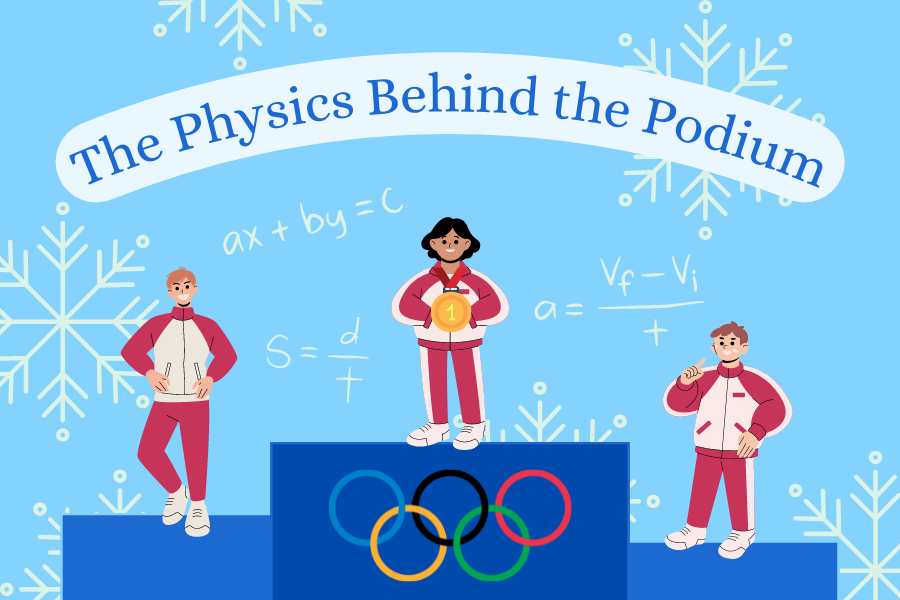The Physics Behind the Podium
The Physics Behind the Podium
Hurtling down an ice track, skiing down a nearly-vertical mountain, jumping on ice with blades attached to your feet—all of these events seem like sure-fire ways to get yourself killed. The best athletes going for the gold at the Beijing 2022 Olympics have physics to thank for their success.
Miniscule Motions
To the untrained eye, the hardest part of luge seems to be holding on to a sled. The athletes don’t seem to be doing anything—they just lie there and ride the track. But beyond the TV screen, a lot more is going on.
The driving force of Olympic sliding events (luge, bobsled, and skeleton) is gravity. Beijing’s Yanqing National Sliding Center has a mile-long track with 16 curves. Over the course of the track, athletes will drop 397 feet. After their initial build-up of speed at the starting line, gravity is the only force causing them to accelerate forward.
Races often come down to the hundredths of seconds, so athletes must be as aerodynamic as possible. That means limiting their contact with air particles that will act opposite to their velocity, also known as a drag force. Air resistance is the reason why luge and skeleton riders are flat on the sled, and why bobsled riders pack so tightly together.
To steer themselves into the fastest path on the track, bobsled and luge riders have steering apparatus built into their sleds. Skeleton riders have no paddles and must make subtle adjustments in their body position to steer the sled. They’re hurtling down the track at such high speeds (up to 90 mph) that even turning your eyeballs to look in a different direction can cause the sled to move.
The most crucial part of any run is the turns. As riders accelerate through these curves, which form part of a circle, they experience a large force inward toward the center of the circle and a large fictitious force outward. The fictitious force causes riders to feel pressed against the outside of the curve, or feel apparently heavier. The ratio of this apparent weight to weight (in this scenario, the force of gravity) is known as g-force. If you’ve ever ridden a Gravitron and felt pressed against the walls of the ride, you’ve experienced a higher than normal g-force.
Normally, we experience 1 G of pressure, or one time the force of gravity. Around curves, riders feel about 4 or 5 Gs of pressure. For reference, astronauts blasting off into space only face about 3 Gs of pressure. As a result, riders have to strain to keep their body, which now feels incredibly heavy, off the ice. Imagine hurtling across a track of ice at incredibly high speeds while steering with perfect precision and working to keep your head from smacking against the ground. Now that’s hard.
Slippery Stones
Curling is the golf of the Winter Olympics—with a little spice. Lots of standing around, eyeing stones, sweeping the seemingly clean ice, and yelling. What is that all about?
Curling stones weigh about 42 pounds, enough to prevent them from stopping prematurely as it slides down the ice (thank inertia). Each team member, alternating every two stones, uses a handle to push the stone forward and cause a slight rotation. This action allows the stone to “curl” down the ice toward a strategic position.
The stone eventually slows to a stop because while ice is smooth, it is not a frictionless surface. Kinetic friction acts opposite to the direction of the stone’s velocity. In addition to affecting the speed of the stone, kinetic friction affects its direction and amount of curl. The front half of the stone exerts the most normal force on the ice. The greater the normal force, the greater the contact between two surfaces. As the front of the stone comes in contact with the ice, it melts a very thin layer of water that decreases friction. The back of the stone has less contact with the ice, so it experiences less of this friction mitigation.
When you turn a stone clockwise, the force of friction acts left on the front of the stone and right on the back of the stone (opposite the direction of the stone’s velocity). Since the friction exerted on the back of the stone is greater, the stone will turn right. The opposite happens when the stone is turned counterclockwise. By changing the amount of contact between the ice and the stone, curlers can change the degree to which the stone curls in a certain direction.
Thus, the goal of curlers is to control the level of friction in order to control the speed and path of the stone. The most recognizable way to do this is by sweeping. The louder the skip yells, the more their teammates sweep! This accomplishes two things: removing pebbling and unevenness in front of the stone and slightly raising the surface temperature of the ice. This second effect is what lessens friction and allows the stone to travel further.
So, curlers aren’t just sweeping for fun. They require quick thinking and a solid strategy in order to perfectly manipulate the frictional forces affecting their stone and knock their opponents out of the house.
Giant Glides
Who said humans can’t fly? In ski jumping, athletes speed down a ramp and launch into the air, then try their best to stay there. Skis are traditionally held in a V position, with arms straight behind the back in an Iron Man-like pose.
Yet, before the 1990s, it was also common to see these skis held parallel to each other and the body. The ski jumpers’ goal was to reduce their collective surface area and, therefore, reduce air resistance. This strategy was effective in helping jumpers cut through the air quickly, but they were missing half of the equation. As skiers launch off the ramp, they are in projectile motion, with a horizontal velocity and vertical velocity. The aerodynamic parallel position helps skiers increase their horizontal velocity and travel further, as long as they stay in the air. However, with little force acting against gravity, it won’t be long before they hit the ground. Instead, athletes need to find a way to balance how fast they’re moving forward with how fast they’re moving down. That’s where the V position comes into play.
The V shape expands the skier’s surface area, forcing air to go around their body and both of their skis. At an angle, the skiers are like an airplane wing. The air over the top of the skier must move faster than the air underneath because it is covering a larger distance (having to go around the skis and the skier’s body) in the same amount of time. The air moving over the top will have lower pressure, as it is moving at a higher speed, and this difference in pressure produces a force called lift. Since lift acts perpendicular to the flow of the air and the angled skier, the force has a horizontal component that pushes the skier back, but also an important vertical component that pushes the skier up, against gravity.
In addition, the benefits of the V position can be explained using Newton’s Third Law: all forces occur in action-reaction pairs that are equal in magnitude and opposite in direction. As the skier’s surface area increases, they are exerting a greater force on the air and the air is, in turn, exerting a greater force on them, allowing them to stay in the air for longer.
A skier’s weight, the length of their skis, and the tightness of their suit are all factors that can affect the amount of lift they receive, so the sport has very tight regulations to level the playing field. Even a couple hundred extra grams, and you’re out.
When races come down to the hundredths of seconds, winning a medal requires more than pure athleticism. Competitors need to understand the intricacies of the physical world in order to gain that slight edge. They may appear to be defying the laws of physics but, in reality, they’ve mastered them.
















